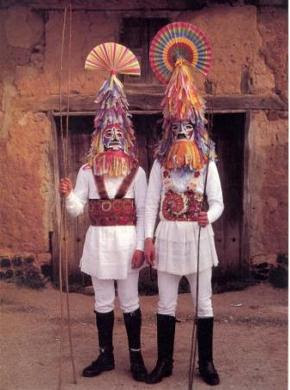 |
The small town of Astorga where we live, began big. It was born as the capital of the Conventus Iuridicus Asturum. In its territory were the richest gold mines in antiquity. Not surprisingly, it was described by Pliny the elder as Urbs Magnífica, or the Great Urban Sphere. But, that was 2000 years ago. Since then much has happened, or as we say, it has rained a lot, although not this winter, and Astorga, with the passage of centuries, has become a lesser known place. Just as we know of places that were born as cow towns and today are capitals. This is life.
No obstante, “el que tuvo retuvo”, y en Astorga se nota un aire noble, culto, importante en todas las esferas; la pequeña población de Astorga y su área de influencia ha dado a la nación importantes escritores, artistas, políticos, empresarios…
However, "what it had it has still retained", and Astorga one notes a noble air, one of culture that is important in every area; the small town of Astorga and its area of influence have given the nation important writers, artists, politicians, businessmen...
Astorga es también la capital de la diócesis y tiene una importante presencia de clero, de conventos y congregaciones religiosas. Lo cual no impide que ya iniciada la cuaresma, el tiempo por excelencia de recogimiento, conversión y penitencia, celebre aún el carnaval por todo lo alto. Este sábado día 25 fue lo que aquí se llama el Sábado de Piñata.
Astorga is also the capital of the diocese and has a significant presence of clergy, religious congregations and convents. This doesn't prevent the already begun Lent, the excellent time of reflection, conversion and penance, and everything high, and includes Carnaval. This Saturday, the 25th, we had here what we call Saturday of the Piñata.
Astorga se vuelca con el carnaval
Astorga is alive with Carnaval
Astorga is alive with Carnaval
Fiesta tradicional en todas las culturas de todos los tiempos y lugares. Constan fiestas de este tipo o antecedentes de ella desde hace más de 5000 años entre los egipcios y los sumerios, pasando por griegos y romanos, hasta el día de hoy sorteando periodos de prohibición y persecución de la fiesta.
Traditional celebrations of all cultures, times and places. The history of festivals of this kind have existed for more than 5000 years between the Egyptians and the Sumerians, passing by the Greeks and Romans, until the present day, having gotten around prohibitions, and persecutions of this festival.
Traditional celebrations of all cultures, times and places. The history of festivals of this kind have existed for more than 5000 years between the Egyptians and the Sumerians, passing by the Greeks and Romans, until the present day, having gotten around prohibitions, and persecutions of this festival.
La encontramos con diferentes nombres y en diversas fechas desde el Año Nuevo hasta que apunta la Primavera.
We found different names and various dates marking the New Year Day until they point to Spring.
Características comunes: subversión de la vida cotidiana, permisividad, exuberancia, exageración, excesos, burlas, parodias y pantomimas, indumentaria estrafalaria, disfraces.
Common features: unusual aspects in everyday life, permissiveness, exuberance, exaggeration, excesses, ridicule, parodies, pantomimes, outlandish clothing and costumes.
Otros términos para designar este tipo de fiesta: guirrios, zamarracos, campanones, entroido, antroxu, etc.
Other terms for this celebration: guirrios, zamarracos, campanones, entroido, antroxu, etc...
 |
| Imágenes del carnaval más tradicional de mi tierra Looks of the most traditional carnival of my country |
Etimológicamente, la palabra carnaval hace referencia a una despedida de la carne pues estamos en las puertas de la cuaresma, tiempo de recogimiento y penitencia, tiempo durante el cual se renuncia determinados días al consumo de carne.
Etymologically, the word carnival means a farewell to the flesh as we are at the gates of Lent, a time of meditation and penance, during which time meat consumption is foregone for certain days.
No dejéis de ver la entrada de mi esposa en su blog sobre este mismo tema. (http://dichossuaves.blogspot.com/2012/02/carnaval.html)






Campanones de Pozos... en la III semana cultural de la Cuesta hice una especie de conferencia y puse la misma fotografía...
ResponderEliminarSabes lo amigo que soy de las tradiciones que configuran nuestra cultura leonesa.
EliminarSaludos y a ver si nos vemos.
Astúrica Augusta, bonita y bella desde fuera y desde dentro. Saludos.
ResponderEliminarNo nací aquí, pero llevo en esta ciudad media vida. La quiero por lo que es y por lo que representa.
EliminarSaludos y gracias por venir y comentar.
Asignatura pendiente para mi, conocerla (no me lo perdono), así que un día habrá que redescubrirla. Un enorme saludo.
ResponderEliminarVenga, sí, estás perdonado si para el próximo año te acercas por aquí.
EliminarUn abrazo.
Astorga is such a charming town and the festival is interesting and fascinating. Everyone looks enjoying being in disguise, but some look scary. Thank you for this intriguing and informative post.
ResponderEliminarDużo ciekawych rzeczy się dowiedziałam i dziękuję za to.Tradycyjne stroje karnawałowe są interesujące i ładne. Karnawał z pewnością jest wspaniały. Pozdrawiam.*** Un montón de cosas interesantes que he aprendido y gracias por to.Tradycyjne trajes de carnaval son interesantes y agradables. El carnaval es sin duda maravilloso. Tuyo.
ResponderEliminar